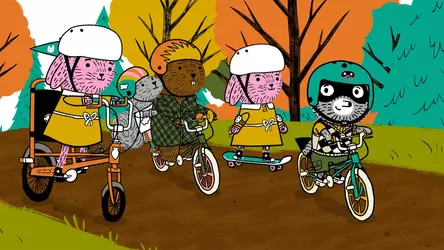
“Carl the Collector” on PBS Kids.
By Nayeli Jaramillo-Plata, CNN
Sat November 16, 2024
PBS Kids’ newest star Carl – a raccoon with autism who collects everything from lint to plush toys – is making history as the network’s first lead character on the spectrum.
“Carl the Collector,” which premiered Thursday, follows Carl and his neurodiverse animal friends as they tackle social interactions and everyday challenges like keeping their room clean. Their adventures give children insight into neurodiversity, fostering empathy and awareness in a fun way.
Show creator Zachariah OHora, a bestselling illustrator and author, said the entire show is based on showing people as they are – both neurotypical and neurodivergent.
“Sometimes a neurodivergent person is going to have a unique take on something that others can learn from,” OHora told CNN in a recent interview. “And at the same time, we don’t gloss over the fact that some social situations and interactions can be more of a struggle for autistic kids and their parents and caretakers.”
OHora began working with PBS Kids almost 10 years ago to develop “Carl the Collector,” and he said the “extra time” was crucial to make sure the story was “told from the heart.” That is why the production team includes neurodiverse writers, animators, advisors and voice talent.
“We just knew from the start that we couldn’t tell other people’s stories for them,” OHora said.
Viewers of the show will see that Carl’s collection isn’t just a hobby – it’s how he makes sense of the world around him and connects with his friends.
Interests termed as “overly focused” like Carl’s are common for people with autism, according to the Centers for Disease Control and Prevention (CDC), as they align with the diagnostic criteria for repetitive behaviors or activities.
Carl also pays exceptional attention to detail. In the second episode, for example, he is the only one in the group able to tell apart Nico and Arugula, identical sisters. This at first creates tension among the friend group, but Carl helps them sharpen their observation skills and resolve the issue, highlighting the value of neurodiversity.
“I hope that autistic kids and their caretakers can feel seen and appreciated, and it’s a vehicle for more conversations about what it means to be human,” OHora said.

“Carl the Collector” on PBS Kids.
Lissette Pedreiras, a 42-year-old mother from New Jersey, is excited to watch the show with her 10-year-old daughter and 8-year-old son Ayden, who has autism.
“Seeing someone like Ayden on screen, especially as a cartoon character, is amazing because he could get to see himself, you know, in someone,” Pedreiras told CNN. “I think it’s important for my daughter, because it’s a little difficult, right? When you have a neurotypical child and a neurodivergent child and explaining how he thinks and how his brain works.”
Though she hasn’t seen the show yet, she has already seen similarities between Ayden and Carl. Her son, who collects toy animals and dinosaurs, is fascinated by anything related to them and shares Carl’s attention to detail.
“The funny thing is, he has such a sharp memory. When he was three or four, he would name dinosaur species, and I thought he was making them up. But no, they were real dinosaur names,” Pedreiras said.
She also views “Carl the Collector” as a valuable tool for sparking conversations about neurodiversity within families. She explained that kids are quick to learn and will develop a better understanding of why children with autism may respond differently in certain situations.
“Anyone in the neurodivergent space, we tend to say not ‘autism awareness,’ it’s more ‘autism acceptance.’ And we want people to understand that we don’t want to change them. We want people to understand them,” Pedreiras said.
“Carl the Collector” airs weekdays at 7:30 am on Nine PBS and streams on PBS KIDS.
